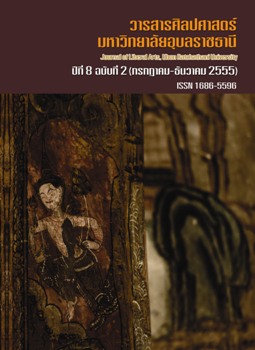CULTURAL HERITAGE AND PRO-POOR TOURISM DEVELOPMENT CASE STUDY: BAN PA AO, MUEANG DISTRICT, UBON RATCHATHANI PROVINCE
Main Article Content
บทคัดย่อ
Thailand has a significant tourist business and this plays a major role in the economy of the country. This researcher is interested in the poor citizens of Thailand and how might tourism play a role in their lives. This research covers the role of tourism in a small village that is located in Northeast Thailand. Since this researcher was born and raised in this part of Thailand, one of the goals of this study was to study the level of benefits from tourism to the poor, which will be accomplished by following the money chain, that is to say, through a supply and money chain analysis. This will help us to see if there is something that can be done about how tourism can benefit the poor as well as the not so poor. Another goal was to find out how cultural heritage plays a role in the tourism industry and finally to examine and study how income is distributed within a specific village. The author covers the history and background of “Pro-Poor Tourism”(PPT) and Cultural Heritage. The conceptual framework of Pro-Poor Tourism wasapplied in this research and is outlined from three sources: first, the Pro-PoorTourism partnership, second the SNV (the Netherland Development Organization), and third the principles and guidelines for managing tourism at places of cultural and heritage significance of the International Council on Monuments and Sites (ICOMOS) International Cultural Tourism Charter. Four case studies on Pro-Poor Tourism are presented in the literature review, on tourism in Africa and Laos. Here the economic and cultural links between the tourist sites are presented. The value chain approach was examined and has proven an effective way of supporting pro-poor development, because it helps us to understand the wider context of development issues, so that we can design interventions for sustainable tourism development. The value chain approach is also one of the vehicles to ensure that the production,income and employment can be increased for the direct benefit of the poor.The literature search also deals with cultural heritage which implies the natural environment as well as the cultural heritage. Cultural heritage has a lot to do with the sense of belonging to an area. Programs are discussed to preserve the environment of historical sites as well as how to promote cultural heritage in support of the drawing of visitors to tourist attractions. Discussed are the training of interpreters and guides thus improving the tourist experience and promotion programmes to help promote tourism. A small village in Northeast Thailand was selected for this study. This researcher discusses the background and history of the Ban Pa-Ao village, which is located in Northeast Thailand, and details the handicrafts that are produced plus the cultural events and environmental forests located nearby. All of these contribute to the income of the villagers. Finally, this research examines and follows the ‘money trail’ that is involved in producing and marketing the village handicrafts of brass and silk products. In addition to the costs, expenditures and sales produced to support the tourist housing, food, beverages, food catering, cultural entertainment and transportation are examined. The results of this money trail analysis give a clear picture that the two big income producers were the two crafts but that each craft spent more than 50% of their income outside of the village for supplies. It was easily concluded that there was a lack of good housing for tourists leading to the possibility that most tourists stay overnight in the larger city of Ubon Ratchatani (Ubon). Hence much of the tourist related village to this village ‘escapes’ to outside its community - the inescapable implication is that this pattern of ‘income escape’ may apply throughout the poor communities of Thailand.
มรดกทางวัฒนธรรมและการพัฒนาการท่องเที่ยวเพื่อสนับสนุนคนยากจน กรณีศึกษา บ้านปะอาว ตำบลปะอาว อำเภอเมือง จังหวัดอุบลราชธานี
ในขณะที่อุตสาหกรรมการท่องเที่ยวได้มีบทบาทส????ำคัญต่อเศรษฐกิจของประเทศไทยผู้วิจัยได้มีความสนใจประชากรคนยากจนในประเด็นที่ว่า การท่องเที่ยวมีบทบาทอย่างไรต่อการดำเนินชีวิตของพวกเขา โดยเน้นหนักในเรื่องเศรษฐกิจ ผู้วิจัยจึงได้ศึกษาบทบาทของการท่องเที่ยวในหมู่บ้านเล็กๆ แห่งหนึ่งในภาคตะวันออกเฉียงเหนือของประเทศไทย ซึ่งเป็นถิ่นกำเนิดของตนเอง การศึกษาระดับของรายได้จากการท่องเที่ยวต่อคนยากจนเป็นหนึ่งวัตถุประสงค์ของการศึกษาในครั้งนี้ โดยได้ทำการติดตามห่วงโซ่เงิน(Money chain) โดยทำการวิเคราะห์ห่วงโซ่อุปาทานและห่วงโซ่เงิน อันจะช่วยให้ค้นพบวิธีการสร้างรายได้จากการท่องเที่ยวแก่คนยากจน วัตถุประสงค์ในการศึกษาต่อมาคือ เพื่อศึกษาบทบาทของมรดกทางวัฒนธรรมในอุตสาหกรรมการท่องเที่ยว และวัตถุประสงค์สุดท้ายได้แก่ ศึกษาการจัดสรรราย ได้จากการท่องเที่ยวภายในหมู่บ้านผู้วิจัยได้ท????ำการศึกษาประวัติความเป็นมาของการท่องเที่ยวเพื่อสนับสนุนคนยากจน(Pro-poor tourism or PPT) และมรดกทางวัฒนธรรม การศึกษาครั้งนี้เกิดขึ้นภายได้กรอบแนวคิดของการท่องเที่ยวเพื่อสนับสนุนคนยากจนจากสามแหล่งหลักๆ ได้แก่ the Pro-poortourism partnership, SNV (the Netherland Development Organization) และ theInternational Council on Monuments and Sites (ICOMOS) กรณีศึกษาสี่แห่งในทวีปแอฟริกาและในประเทศลาวที่ซึ่งการท่องเที่ยวได้เชื่อมโยงระหว่างเศรษฐกิจและวัฒนธรรม ได้ถูกนำมาเสนอในส่วนของการศึกษาวรรณกรรมที่เกี่ยวข้อง โดยพบว่าห่วงโซ่คุณค่า (Value chain) ได้ถูกพิสูจน์ว่าเป็นเครื่องมือที่มีประสิทธิภาพในการส่งเสริมและพัฒนาการท่องเที่ยวเพื่อสนับสนุนคนยากจนได้ เนื่องจากมันช่วยให้เราเข้าใจบริบทของการพัฒนาในแง่มุมที่กว้างขึ้น ซึ่งทำให้เราสามารถวางแผนการพัฒนาการท่องเที่ยวได้อย่างยั่งยืน ห่วงโซ่คุณค่ายังเป็นหนึ่งในกลไกที่ช่วยให้เราแน่ใจว่ากระบวนการผลิต รายได้และการจ้างงาน สามารถสร้างรายได้โดยตรงแก่คนยากจน นอกจากนี้ จากการทบทวนวรรณกรรมยังพบว่ายังมีอะไรที่ต้องทำอีกมากกับมรดกทางวัฒนธรรมในพื้นที่หนึ่งๆ ซึ่งส่วนมากจะเกี่ยวข้องกับประเด็นการอนุรักษ์สภาพแวดล้อมทางประวัติศาสตร์ในขณะที่ต้องการส่งเสริมให้มรดกทางวัฒนธรรมเป็นสินค้าหนึ่งของการท่องเที่ยว และสิ่งที่ถูกนำมาอภิปรายมากอีกประเด็นหนึ่งได้แก่การฝึกหัดผู้สื่อความหมาย (Interpreter)และไกด์นำเที่ยวในพื้นที่ เพราะคนเหล่านี้มีผลอย่างมากต่อ ประสบการณ์ของนักท่องเที่ยวและการประชาสัมพันธ์การท่องเที่ยวในพื้นที่บ้านปะอาว หมู่บ้านเล็กๆ แห่งหนึ่งในภาคตะวันออกเฉียงเหนือได้ถูกเลือกให้เป็นกรณีศึกษา ผู้วิจัยได้อภิปรายภูมิหลังรวมถึงประวัติความเป็นมา งานหัตถกรรม ธุรกิจบริการกิจกรรมทางวัฒนธรรม รวมถึงป่าชุมชน ซึ่งเป็นแหล่งท่องเที่ยวของหมู่บ้าน ผู้วิจัยได้ศึกษาและติดตามเส้นทางของเงินรายได้ที่เกิดจากการท่องเที่ยว ที่เกี่ยวเนื่องกับกระบวนการผลิตและการตลาดของสินค้าทางหัตถกรรม(งานหล่อทองเหลืองและผลิตภัณฑ์จากผ้าไหม) มรดกทางวัฒนธรรมของหมู่บ้านที่สืบสานต่อกันมาหลายชั่วอายุคน นอกจากนี้ยังได้ศึกษาต้นทุน รายได้และรายจ่ายจากการขายผลิตภัณฑ์หัตถกรรม ธุรกิจที่พักแบบโฮมสเตย์ การบริการอาหารและเครื่องดื่ม การแสดงศิลปะพื้นบ้านและการขนส่งจากการศึกษาติดตามเส้นทางของเงินรายได้ที่เกิดจากกิจกรรมทางการท่องเที่ยว พบว่างานหัตถกรรมการหล่อทองเหลืองและผลิตภัณฑ์ผ้าไหมเป็นแหล่งที่สร้างรายได้หลักให้กับหมู่บ้าน แต่เป็นที่น่าเสียดาย เพราะมากกว่า 50% ของรายได้ได้รั่วไหลออกนอกหมู่บ้านไปยังผู้จัดหา (Suppliers) ซึ่งอยู่ในตัวจังหวัด ในขณะที่หมู่บ้านเองก็ขาดศักยภาพในการดึงดูดนักท่องเที่ยวให้พักค้างคืนในหมู่บ้านซึ่งทำให้รายได้ส่วนใหญ่รั่วไหลออกจากหมู่บ้านเช่นกัน


